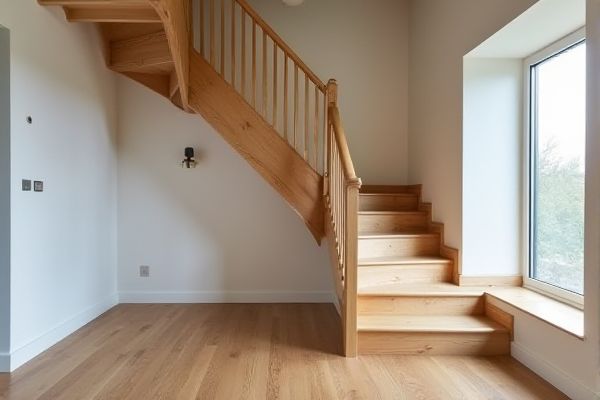
A scissor staircase features two interlocking flights of stairs within a single shaft, optimizing space in high-rise buildings, while a dog-leg staircase consists of two flights connected by a landing that changes direction, commonly used in residential settings for efficient floor transitions. Discover the key differences and advantages of each design to determine which staircase best suits your architectural needs in the full article.
Table of Comparison
| Feature | Scissor Staircase | Dog-Leg Staircase |
|---|---|---|
| Design | Two interlocking stair flights within the same shaft | Two straight flights connected by a landing, forming a 90-degree turn |
| Space Efficiency | Highly space-efficient, ideal for narrow shafts | Moderate space usage with landing area |
| Safety | Separate egresses, commonly used for emergency exits | Good safety, provides resting landing |
| Construction Complexity | Complex due to overlapping flights | Relatively simple construction |
| Application | Multi-story buildings, fire escapes | Residential and commercial buildings |
| Cost | Higher due to complexity and materials | Generally lower construction cost |
Introduction to Scissor and Dog-Leg Staircases
Scissor staircases consist of two interlocking flights within a single stairwell, maximizing space efficiency and providing separate escape routes, ideal for high-rise buildings. Dog-leg staircases feature two straight flights connected by a landing, turning 180 degrees without a continuous slope, commonly found in residential and commercial properties for ease of construction. Your choice depends on spatial constraints and safety requirements, with scissor stairs emphasizing compactness and dog-leg stairs offering straightforward design.
Key Differences Between Scissor and Dog-Leg Staircases
Scissor staircases feature two interlocking flights of stairs within a single stairwell, optimizing space in high-rise buildings and enhancing fire safety with separate escape routes. Dog-leg staircases consist of two flights connected by a landing that changes direction, often used in residential settings for efficient vertical circulation and aesthetic appeal. Your choice between these designs depends on building codes, space constraints, and the desired architectural style.
Design Features of Scissor Staircases
Scissor staircases feature two interlocking flights of stairs within a single stairwell, enabling efficient use of vertical space and enhanced fire escape routes. Their design allows for separate upward and downward paths without a landing in between, optimizing building footprint and compliance with safety regulations. You benefit from improved circulation and increased structural integrity in multi-story buildings when choosing scissor staircases.
Design Features of Dog-Leg Staircases
Dog-leg staircases feature a single flight with a 180-degree turn via a landing, creating a compact and space-efficient design ideal for tight floor plans. Their design eliminates the need for a large stairwell opening, maximizing usable floor area and providing a safer, enclosed stairway environment. The landing serves as a resting point, enhancing comfort and accessibility, especially in multi-story residential or commercial buildings.
Space Efficiency: Scissor vs Dog-Leg Staircases
Scissor staircases maximize space efficiency by overlapping two flights within a single stairwell, making them ideal for high-density buildings with limited floor area. Dog-leg staircases require more horizontal space due to their two flights connected by a landing that changes direction, resulting in a larger footprint. For compact architectural designs, scissor staircases offer superior space-saving advantages compared to dog-leg staircases.
Structural Considerations and Load Distribution
Scissor staircases feature intertwined flights inside a single shaft, demanding precise structural support to manage concentrated loads from overlapping stairs, which often requires reinforced beams and columns. Dog-leg staircases consist of two straight flights connected by a landing, distributing loads more evenly along the stringers and reducing the need for complex support systems. Your choice between these designs should consider the building's load capacity and structural framework to ensure stability and safety.
Safety and Accessibility Comparison
Scissor staircases provide enhanced safety by featuring two parallel stair flights enclosed within a single shaft, allowing for efficient emergency evacuation and reduced crowding hazards. Dog-leg staircases, characterized by a 180-degree turn with a landing, offer improved accessibility through intermediate resting points and easier navigation for people with limited mobility. Both designs adhere to building codes, but scissor staircases prioritize fire safety in multi-story buildings, while dog-leg staircases emphasize user comfort and accessibility.
Aesthetic Appeal and Architectural Style
Scissor staircases feature interlocking flights that create a dynamic, modern aesthetic suited for contemporary architectural styles, enhancing visual complexity in limited spaces. Dog-leg staircases offer a more traditional, classic appeal with a 180-degree turn, complementing both traditional and transitional interior designs through their simplicity and elegance. Both designs influence spatial perception, with scissor staircases emphasizing structural innovation and dog-leg stairs promoting a balanced, timeless look.
Cost Implications and Material Choices
Scissor staircases typically involve higher construction costs due to their complex overlapping design, requiring more steel or reinforced concrete for structural integrity. Dog-leg staircases are generally more cost-effective, utilizing simpler layouts with fewer materials such as timber or standard concrete, which reduces overall expenses. Your choice should consider budgets and desired material durability, as scissor staircases often demand premium finishes and fire-resistant materials, while dog-leg designs allow for more economical options.
Choosing the Right Staircase for Your Building
Selecting the right staircase for your building depends on space, functionality, and design preferences. Scissor staircases provide compact, efficient use of vertical space with two interwoven flights, ideal for emergency egress in multi-story buildings. Dog-leg staircases fit well in tighter floor plans with a landing that changes direction, offering ease of use and aesthetic appeal for residential or commercial settings.
 homyna.com
homyna.com